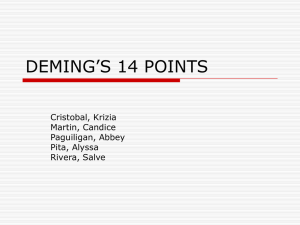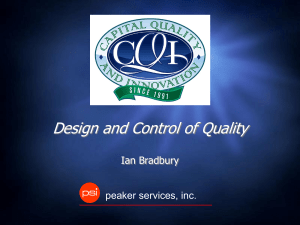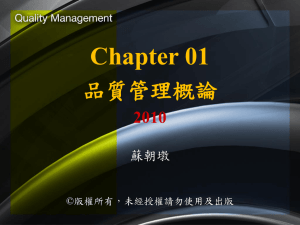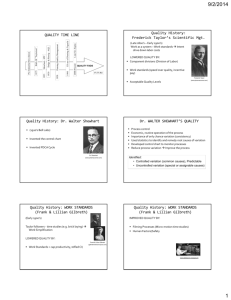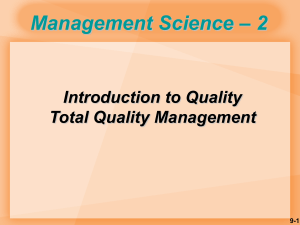Introduction to Quality
advertisement
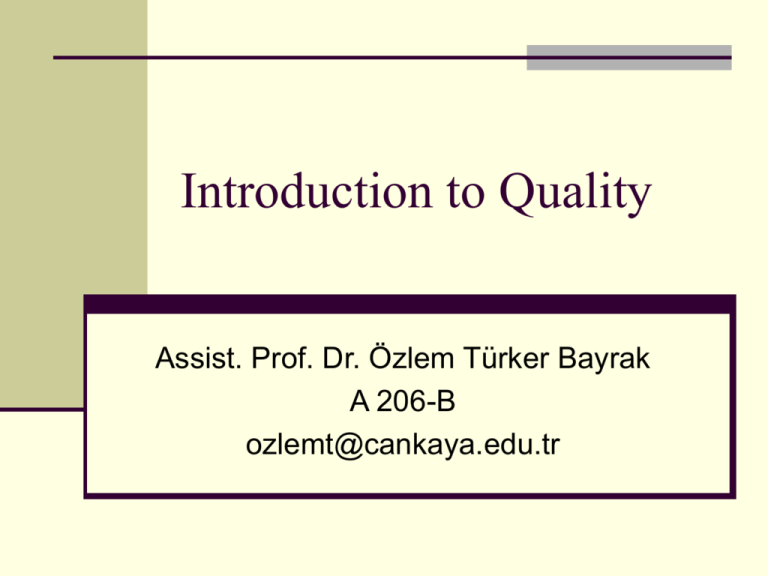
Introduction to Quality Assist. Prof. Dr. Özlem Türker Bayrak A 206-B ozlemt@cankaya.edu.tr Outline What is Quality? History of Quality Methodology Deming’s Principles Taguchi’s Contributions And Philosophy Total Quality Management Quality Improvement Tools Costs related to quality Benefits/Drawbacks What is Quality? What does the word “quality” mean to you? Think about your past experiences staying at various hotels. Did you stay at a “quality” hotel? What about the experience made it a “quality” experience for you? Think about a product you bought. How can you define its “quality”? Dimensions of Quality Garvin (1987) 1. Performance: Will the product/service do the intended job? 2. Reliability: How often does the product/service fail? 3. Durability: How long does the product/service last? 4. Serviceability: How easy to repair the product / to solve the problems in service? Dimensions of Quality 5. Aesthetics: 6. Features: 7. What does the product do/ service give? Perceived Quality: 8. What does the product/service look/smell/sound/feel like? What is the reputation of the company or its products/services? Conformance to Standards: Is the product/service made exactly as the designer/standard intended? Quality in different areas of society Area Examples Airlines On-time, comfortable, low-cost service Health Care Correct diagnosis, minimum wait time, lower cost, security Food Services Good product, fast delivery, good environment Postal Services fast delivery, correct delivery, cost containment Academia Proper preparation for future, on-time knowledge delivery Consumer Products Properly made, defect-free, cost effective Insurance Payoff on time, reasonable cost Military Rapid deployment, decreased wages, no graft Automotive Defect-free Communications Clearer, faster, cheaper service What is Quality? Conformance to specifications (British Defense Industries Quality Assurance Panel) Conformance to requirements (Philip Crosby) Fitness for purpose or use (Juran) A predictable degree of uniformity and dependability, at low cost and suited to the market (Edward Deming) Synonymous with customer needs and expectations (R J Mortiboys) Meeting the (stated) requirements of the customer- now and in the future (Mike Robinson) The total composite product and service characteristics of marketing, engineering, manufacturing and maintenance through which the product and service in use will meet the expectations by the customer (Armand Feigenbaum) What is Quality? “The degree to which a system, component, or process meets (1) specified requirements, and (2) customer or users needs or expectations” – IEEE The totality of features and characteristics of a product or service that bears on its ability to satisfy stated or implied needs” – ISO 8402 Degree to which a set of inherent characteristics fulfils requirements – ISO 9000:2000 Definitions of Quality Transcendent definition: excellence Product-based definition: quantities of product attributes User-based definition: fitness for intended use; meeting or exceeding user expectations Value-based definition: quality vs. price Manufacturing-based definition: conformance to specifications 10 More about Quality Realistic but demanding STANDARDS; Getting things RIGHT FIRST TIME; ‘It costs less to prevent a problem than it does to correct it’ Influences the relationship with CUSTOMERS; Influences how COMPLAINTS are dealt with; Something to do with how things LOOK and FEEL. Modern Importance of Quality “The first job we have is to turn out quality merchandise that consumers will buy and keep on buying. If we produce it efficiently and economically, we will earn a profit.” - William Cooper Procter 12 History of Quality Methodology Reach back into antiquity, especially into China, India, Greece and the Roman Empire : skilled crafstmanship. Industrial Revolution (18th century): need for more consistent products that are massproduced and needed to be interchangeable. Rise of inspection after manufacturing completed and separate quality departments. 13 History of Quality Methodology Science of modern quality methodology started by R. A. Fisher perfected scientific shortcuts for shifting through mountains of data to spot key ccause-effect relationships to speed up development of crop growing methods. Statistical methods at Bell Laboratories: W. A. Shewhart transformed Fisher’s methods into quality control discipline for factories (inspired W.E. Deming and J. M. Juran); Control Charts developed by W. A. Shewhart; Acceptance sampling methodology developed by H. F. Dodge and H. G. Romig 14 History of Quality Methodology World War II: Acceptance of statistical quality-control concepts in manufacturing industries (more sophisticated weapons demanded more careful production and reliability); The American Society for Quality Control formed (1946). Quality in Japan: W.E. Deming invited to Japan to give lectures; G. Taguchi developed “Taguchi method” for scientific design of experiments; The Japanese Union of Scientists and Engineers (JUSE) established “Deming Price” (1951); The Quality Control Circle concept is introduced by K. Ishikawa (1960). 15 History of Quality Methodology Quality awareness in U.S. manufacturing industry during 1980s: “Total Quality Management”; Quality control started to be used as a mangement tool. Malcolm Baldrige National Quality Award (1987) International Standard Organization’s (ISO) 9000 series of standards: in 1980s Western Europe began to use; interest increase in US industry in 1990s; Became widely accepted today: necessary requirement to world-wide distribution of product and a significant competitive advantage. 16 History of Quality Methodology Quality in service industries, government, health care, and education Current and future challenge: keep progress in quality management alive To sum up: A gradual transition Statistical Quality Control Quality Assurance Quality Management 17 Deming’s 14 Principles. “Create Constancy of Purpose” 1. Define the problems of today and the future Allocate resources for long-term planning Allocate resources for research and education Constantly improve design of product and service “Adopt A New Philosophy” 2. Quality costs less not more Superstitious learning The call for major change Stop looking at your competition and look at your customer instead “Cease Dependence On Inspection For Quality” 3. Quality does not come from inspection Mass inspection is unreliable, costly, and ineffective Inspectors fail to agree with each other Inspection should be used to collect data for process control Deming’s 14 Principles. “End Proactive Awarding Of Business Based On PriceAlone” 4. Price alone has no meaning Change focus from lowest inital cost to lowest cost Work toward a single source and long term relationship Establish a mutual confidence and aid between purchaser and vendor “Improve Every Process Constantly / Forever” 5. Quality starts qith the intend of management Teamwork in design is fundamental Forever continue to reduce waste and continue to improve Putting out fires is not improvement of the process “Institute Training” 6. Management must provide the setting where workers can be succesful Management must remove the inhibitors to good work Management needs an appreciation of variation This is management’s new role Deming’s 14 Principles. “Adopt And Institute Leadership” 7. Remove barriers to pride of workmanship Know the work they supervise Know the difference between special and common cause of variation “Drive Out Fear” 8. The common denominator of fear: Fear of knowledge Performance appraisals Management by fear or numbers “Break Barriers Between Staff Areas” 9. Know your internal suppliers and customers Promote team work “Eliminate Slogans, Exhortations And Targets” 10. They generate frustration and resentment Use posters that explain what management is doing to improve the work environment Deming’s 14 Principles. “Eliminate Numerical Quotas” 11. They impede quality They reduce production The person’s job becomes meeting a quota “Remove Barriers That Rob Pride Of Workmanship” 12. Performance appraisal systems Production rates Financial management systems Allow people to take pride in their workmanship “Institute Programs For Education And Self Improvement” 13. Commitment to lifelong employment Work with higher education needs Develop team building skills “Put Everybody In The Company To Work For This Transformation” 14. Struggle over the 14 points Take pride in new philosophy Include the critical mass of people in the change QUALITY DOES NOT OCCUR BY ACCIDENT What does the customer actually want? Identify, understand and agree customer requirements How are you going to meet those requirements? Plan to achieve them Deming’s Cycle What are we trying to accomplish? AIM How will we know that a change is an improvement? What change can we make that will result in improvement? MEASURE Selecting Change Plan Plan P P Act Do A D A A P D C C C Check Check Do D Taguchi’s Contribution In the early 1980s, Prof. Genechi Taguchi introduced his approach to using experimental design for 1) 2) 3) Designing products or processes so that they are robust to environmental conditions. Designing/developing products so that they are robust to component variation. Minimizing variation around a target value. By robust, we mean that the product or process performs consistently on target and is relatively insensitive to factors that are difficult to control. Taguchi Philosophy 3 stages in a product’s (or process’s) development: 1) 2) 3) System design: uses scientific and engineering principles to determine the basic configuration. Parameter design: specific values for the system parameters are determined. Tolerance design: determine the best tolerances for the parameters. Taguchi Philosophy Recommends: statistical experimental design methods have to be used for quality improvement, particularly during parameter and tolerance design phases. Key component: reduce the variability around the target (nominal) value. Quality Management Quality Management System: Management system to direct and control an organisation with regard to quality – ISO 9000:2000 Quality Management Quality Planning Quality Assurance Quality Control Criteria driven Prevention driven Inspection driven Quality Management Components Quality Planning It identifies the standards and determines how to satisfy those standards. It lays out the roles and responsibilities, resources, procedures, and processes to be utilized for quality control and quality assurance. Quality Assurance It is the review to ensure aligning with the quality standards. An assessment will be provided here. Planned and systematic quality activities. Provide the confidence that the standards will be met. Quality Control – Inspection Driven Quality Control It addresses the assessment conducted during Quality Assurance for corrective actions. Measure specific results to determine that they match the standards. Use of Statistical Process Control (SPC) : a methodology for monitoring a process to identify special causes of variation and signal the need to take corrective action when appropriate. SPC relies on control charts. What is a Control Chart? A control chart is a presentation of data in which the control values are plotted against time. Control charts have a central line, upper and lower warning limits, and upper and lower action limits. Immediate visualisation of problems. Control chart -illustration of construction Central line X-chart Copper Action limit Warning limit 1.3 1.2 1.1 1.0 0.9 0.8 0 10 20 30 40 50 60 Control value 70 80 90 100 When to Take Action? One point plots outside the Action Limits. Two consecutive points plots between the Warning and Action Limits Eight consecutive points plot on one side of the Center Line Six points plots steadily increasing or decreasing When an unusual or nonrandom pattern is observed When to Take Action? 4 3 2 1 0 1 2 3 4 5 6 7 8 -1 -2 -3 -4 Month 9 10 11 12 13 14 15 When to Take Action? 4 3 2 1 0 1 2 3 4 5 6 7 8 -1 -2 -3 -4 Month 9 10 11 12 13 14 15 When to Take Action? 4 3 2 1 0 1 2 3 4 5 6 7 8 -1 -2 -3 -4 Month 9 10 11 12 13 14 15 Quality Improvement Tools Brainstorming Nominal Group Technique Cause & Effect Flow Diagram Brainstorming Everyone participates Go round robin and only one person speaks at a time No discussion of ideas There is no such thing as a dumb idea Pass when necessary Use “BIG” yellow sticky notes and write only 1 idea per sticky note One person assigned as scribe For a complicated issue, the session could last 30-45 minutes…or longer! Nominal Group Technique Use a Nominal Group Technique To focus brainstorming results An internet search on “Nominal Group Technique” Will yield many examples and methods to apply this technique Flow Diagrams Why is flow diagramming helpful? Build a common understanding of a whole process Develop process thinking Improve a process Standardize a process Week4_4 Week 4_5 Investigate the Root Causes Understand the root causes of a problem BEFORE you put a “solution” into place Cause & Effect Diagrams Why are cause and effect diagrams helpful? Root cause Root cause Identify and display many different possible causes for a problem See the relationships Focused problem between the many causes Helps determine which Root cause Root cause data to collect How To Construct Cause & Effect Diagrams •Clearly define the focused problem •Use brainstorming to identify possible causes •Sort causes into reasonable clusters (no less than 3, not more than 6) •Label the clusters (consider people, policies, procedures, materials if you have not already identified labels) •Develop and arrange bones in each cluster •Check the logical validity of each causal chain Building a Cause & Effect Diagram Materials Lack of office space Policies Minimal benefits Location Restrictive budget Escorting clients to appointments and having to wait No policy on staff screening Turnover in staff “Back-biting” environment Paperwork Burnout overwhelming Procedures Lack of supervision Inadequate training People Cause & Effect Diagrams Bones should not include solutions Bones should not include lists of process steps Bones include the possible causes Better understand the current situation….. Now begin to develop a change. To Summarize…. Brainstorming Nominal Group Technique Flow Diagram Cause & Effect Diagram Histogram Used to visualize the distribution Histogram of univariate sample 0.08 Density 0.06 0.04 0.02 0.00 20 30 40 measurement scale 50 Histogram Histogram of univariate sample - bimodal tendency 0.04 Density 0.03 0.02 0.01 0.00 20 40 60 measurement scale 80 Histogram Histogram of univariate sample - skewed tendency 0.04 Density 0.03 0.02 0.01 0.00 0 20 40 measurement scale 60 80 Pareto Chart Chart consistencies of most frequent defects Used to locate Major sources of problems Able to use with Count and Categorical Data Example Pareto Chart Example Pareto Chart 120 100 100 Count 60 60 40 40 20 20 0 sample1 Count Percent Cum % red 53 49.1 49.1 blue 27 25.0 74.1 green 19 17.6 91.7 yellow 7 6.5 98.1 Other 2 1.9 100.0 0 Percent 80 80 Control Charts Used to determine if variation is chance or assignable cause Good for measuring control of variation Control needed before Change More appropriately applied to process rather than product Quality-related costs Prevention costs activities to keep unacceptable products from being generated and to keep track of the process Appraisal costs activities to maintain control of the system Correction costs activities to correct conditions out of control, including errors Prevention costs Quality planning and engineering New products review Product/process design Process control Burn-in Training Quality data acquisition and analysis Appraisal costs Inspection and test of incoming material Product inspection and test Materials and services consumed Maintaining accuracy of test equipment Correction costs 1. Internal Failure Costs: Scrap Rework Retest Failure analysis Downtime Yield losses Downgrading (off-specing) Correction costs 2. External Failure Costs: Complaint adjustment Returned product/material Warranty charges Liability costs Indirect costs Cost of implementing quality management, accreditation and quality assurance correction c o s t quality management and assurance total time Internal and External Benefits of Quality Internal Benefits Reduces costs Increases dependability Increases speed Boosts moral Increases customer retention Increases profit External Benefits Customer gets correct product or service Correct specifications Appropriate intangibles Customer satisfaction Customer retention Drawbacks Long way to establish in the organisation QM design not always fit for purpose (loss of cost effectiveness) Substantial efforts Maintain system, otherwise reject it.
